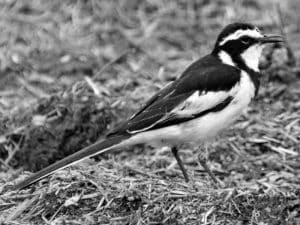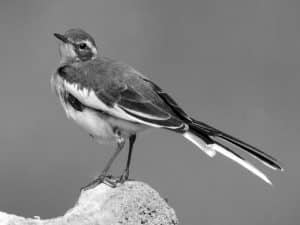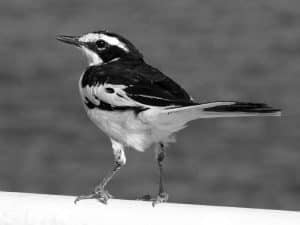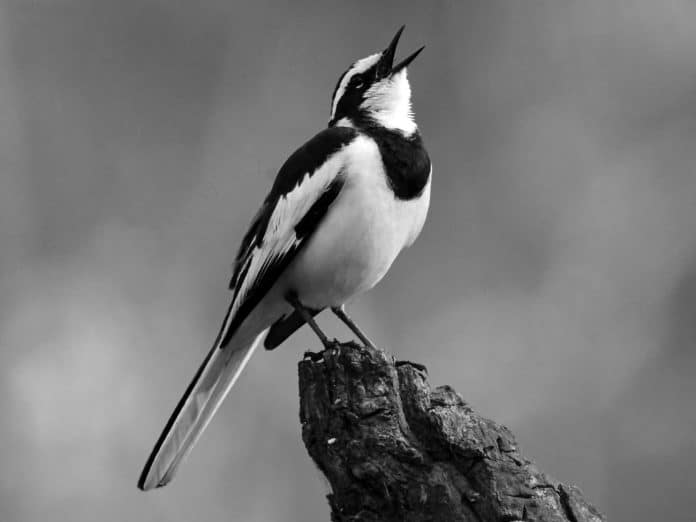Introduction to the African Pied Wagtail
Nestled within the vast and diverse landscapes of Tanzania, a captivating bird species known as the African Pied Wagtail (Motacilla aguimp) captivates the hearts of birdwatchers and nature enthusiasts alike. This striking avian beauty, with its distinctive black-and-white plumage and graceful wagging tail, is a true gem of Tanzania’s vibrant avian tapestry. As you delve into the world of the African Pied Wagtail in Tanzania, you’ll uncover a fascinating tale of adaptation, survival, and the intricate role this species plays within the delicate balance of the ecosystem.
Habitat and Distribution of the African Pied Wagtail in Tanzania

The African Pied Wagtail is widely distributed across Tanzania, thriving in a variety of habitats that cater to its unique needs. From the lush riverbanks and wetlands to the bustling urban centers, this adaptable species has carved out a niche for itself, flourishing in the diverse landscapes of the country.
In Tanzania, the African Pied Wagtail can be found in the following regions:
- The Serengeti National Park: This iconic wildlife haven is home to a thriving population of African Pied Wagtails, who can be spotted along the banks of the Mara River and other water sources.
- Ngorongoro Conservation Area: The stunning Ngorongoro Crater, a UNESCO World Heritage Site, provides a haven for the African Pied Wagtail, where they can be seen foraging and nesting along the crater’s rim.
- Ruaha National Park: This expansive park, known for its diverse wildlife, also boasts a healthy population of African Pied Wagtails, particularly around the Ruaha River and its tributaries.
- Coastal regions: The coastal areas of Tanzania, including Dar es Salaam and Zanzibar, are home to African Pied Wagtails, who thrive in the proximity of the ocean and its associated habitats.
As you explore these remarkable regions, keep your eyes peeled for the graceful movements and striking plumage of the African Pied Wagtail, a true ambassador of Tanzania’s avian diversity.
Physical Description and Identification of the African Pied Wagtail
The African Pied Wagtail is a striking and distinctive bird, with a unique appearance that sets it apart from its avian counterparts. With a sleek, slender build and a long, wagging tail, this species is easily recognizable, even to the untrained eye.
The most prominent feature of the African Pied Wagtail is its contrasting black-and-white plumage. The bird’s head, back, and wings are a deep, glossy black, while its belly, chest, and rump are a brilliant white. This striking color pattern, coupled with the bird’s long, thin legs and elongated tail, create a visually captivating appearance that is sure to catch your attention.
As you observe the African Pied Wagtail, you’ll notice its graceful, almost dance-like movements, as it constantly wags its tail from side to side, almost as if it’s keeping time to an unheard rhythm. This unique behavior, combined with its striking appearance, makes the African Pied Wagtail a true delight to behold.
To further aid in your identification, the African Pied Wagtail also has a distinct call, a high-pitched “chissick” or “chizzeep” that can often be heard as it flits from one perch to another. By familiarizing yourself with both the visual and auditory cues, you’ll be well-equipped to spot and identify this avian gem during your travels in Tanzania.
Behavior and Mating Habits of the African Pied Wagtail
The African Pied Wagtail is a fascinating bird, not only in its appearance but also in its behavior and mating habits. These intriguing aspects of the species’ life cycle offer a deeper understanding of its role within the Tanzanian ecosystem.
One of the most distinctive behaviors of the African Pied Wagtail is its constant tail-wagging motion. This rhythmic movement is believed to serve multiple purposes, including attracting mates, signaling territorial boundaries, and aiding in the detection of prey. As the bird forages along the ground or perches on rocks and branches, its tail continuously sways back and forth, creating a mesmerizing display.
When it comes to mating, the African Pied Wagtail engages in a captivating courtship ritual. During the breeding season, males will perform elaborate displays, including fluttering flights, wing-spreading, and even aerial chases, all in an effort to attract a suitable mate. Once a pair has formed, they work together to construct a well-concealed nest, often in the crevices of rocks or buildings, or in the dense vegetation along riverbanks.
The female African Pied Wagtail typically lays a clutch of 4-5 eggs, which both parents take turns incubating. Once the chicks hatch, the parents work tirelessly to provide food and care for their offspring, ensuring their survival and successful fledging. This dedication to their young is a testament to the species’ adaptability and the important role they play in the broader ecosystem.
As you observe the African Pied Wagtail in its natural habitat, take the time to witness these fascinating behaviors and mating rituals, which offer a glimpse into the intricate lives of these captivating birds.
Diet and Feeding Patterns of the African Pied Wagtail
The African Pied Wagtail is a versatile and opportunistic feeder, adapting its diet to the abundance of resources available in its diverse Tanzanian habitats. This adaptability allows the species to thrive in a wide range of environments, contributing to its successful distribution throughout the country.
The primary components of the African Pied Wagtail’s diet include:
- Insects: This bird is an avid insect hunter, feeding on a variety of small insects, such as flies, beetles, spiders, and even small aquatic invertebrates found near water sources.
- Arachnids: The African Pied Wagtail also preys on small spiders and other arachnids, helping to maintain a balanced ecosystem by controlling the populations of these arthropods.
- Small vertebrates: On occasion, the African Pied Wagtail may supplement its diet with small vertebrates, such as lizards, frogs, or even small fish, particularly in areas where these resources are abundant.
In terms of feeding patterns, the African Pied Wagtail is a versatile forager, employing a range of techniques to capture its prey. You may observe these birds hopping and running along the ground, fluttering and darting in the air, or even wading in shallow waters to hunt for aquatic organisms. Their constant tail-wagging motion is believed to aid in the detection of prey, as well as in maintaining balance and stability while foraging.
As an integral part of the Tanzanian ecosystem, the African Pied Wagtail plays a crucial role in the regulation of insect and small vertebrate populations, contributing to the overall health and balance of the natural environment.
Conservation Status and Threats to the African Pied Wagtail

The African Pied Wagtail is currently classified as a species of Least Concern by the International Union for Conservation of Nature (IUCN), indicating that its overall population is stable and not facing immediate threats of extinction. However, like many other species, the African Pied Wagtail does face a number of potential challenges that could impact its long-term survival.
One of the primary threats to the African Pied Wagtail is habitat loss and degradation. As human development and urbanization continue to expand across Tanzania, the natural habitats that the wagtail relies on, such as riverbanks, wetlands, and coastal areas, are increasingly under pressure. This can lead to a decline in suitable nesting sites, foraging grounds, and overall resource availability for the species.
Additionally, the use of pesticides and other agricultural chemicals can have a detrimental effect on the African Pied Wagtail’s food sources, leading to a reduction in the availability of insects and other prey. This, in turn, can impact the species’ breeding success and overall population health.
Climate change also poses a potential threat to the African Pied Wagtail, as shifts in temperature, precipitation patterns, and the availability of water resources can disrupt the delicate balance of the species’ preferred habitats.
To ensure the long-term conservation of the African Pied Wagtail in Tanzania, it is crucial to implement sustainable land-use practices, promote the preservation of natural habitats, and reduce the use of harmful chemicals in agriculture. By taking these steps, we can help to safeguard the future of this captivating avian species and maintain the rich biodiversity of Tanzania’s ecosystems.
Importance of the African Pied Wagtail in the Ecosystem
The African Pied Wagtail plays a vital role in the intricate web of Tanzania’s ecosystem, contributing to the overall health and balance of the natural environment. As a versatile and adaptable species, the African Pied Wagtail fulfills several important ecological functions.
- Pest Control: As a voracious predator of insects and small invertebrates, the African Pied Wagtail helps to regulate the populations of these organisms, preventing them from becoming agricultural pests or nuisances in urban areas.
- Nutrient Cycling: Through their foraging activities and the deposition of their droppings, African Pied Wagtails play a role in the cycling of nutrients within the ecosystem, contributing to the overall productivity and resilience of the environment.
- Bioindicator: The presence and abundance of African Pied Wagtails can serve as a bioindicator of the overall health and quality of the habitats they occupy. Monitoring their populations can provide valuable insights into the state of the ecosystem.
- Biodiversity Maintenance: By maintaining a balanced population of insects, arachnids, and small vertebrates, the African Pied Wagtail helps to preserve the biodiversity of the Tanzanian landscape, supporting the survival of a wide range of other species.
- Ecotourism and Birdwatching: The striking appearance and unique behaviors of the African Pied Wagtail make it a popular target for birdwatchers and nature enthusiasts visiting Tanzania, contributing to the country’s ecotourism industry and promoting environmental awareness.
By recognizing the vital role the African Pied Wagtail plays in the Tanzanian ecosystem, we can better appreciate the importance of conserving and protecting this captivating avian species for generations to come.
Birdwatching and Photography Tips for Spotting the African Pied Wagtail in Tanzania
For birdwatchers and nature photographers visiting Tanzania, the African Pied Wagtail is a must-see species. With its striking appearance and engaging behaviors, the wagtail is a true delight to observe and capture through the lens. To increase your chances of spotting and photographing this avian gem, consider the following tips:
- Habitat Identification: Familiarize yourself with the preferred habitats of the African Pied Wagtail, such as riverbanks, wetlands, and urban areas. Focusing your search in these locations will greatly improve your chances of encountering the species.
- Timing and Patience: African Pied Wagtails are most active during the early morning and late afternoon hours, when they are foraging and engaging in their characteristic tail-wagging behavior. Be prepared to spend time observing and waiting patiently for the perfect moment to capture your shots.
- Quiet Approach: These birds are relatively approachable, but it’s important to move slowly and quietly to avoid startling them. Keeping a respectful distance and avoiding sudden movements will allow you to observe their natural behaviors.
- Utilize Vantage Points: Seek out elevated vantage points, such as hilltops or raised platforms, to scan the surrounding area for the distinctive black-and-white silhouette of the African Pied Wagtail.
- Employ Stealth Techniques: When photographing the wagtail, use camouflage or blend into the environment to minimize your presence and increase your chances of capturing uninterrupted, natural behavior.
- Familiarize with Calls: Learn to recognize the high-pitched “chissick” or “chizzeep” call of the African Pied Wagtail, as this can help you locate and identify the species, even when they are not in plain sight.
- Explore Diverse Locations: While the Serengeti and Ngorongoro Crater are popular destinations, don’t overlook the coastal regions and urban areas of Tanzania, as the African Pied Wagtail can be found in a variety of habitats across the country.
By following these tips and embracing the thrill of the hunt, you’ll be well on your way to discovering the captivating African Pied Wagtail and capturing its beauty through your lens during your travels in Tanzania.
Other Bird species Found in Tanzania’s Avian Pied Beauty
While the African Pied Wagtail is undoubtedly a highlight of Tanzania’s avian diversity, it is just one of the many remarkable bird species found within the country’s vast and varied landscapes. As you explore the natural wonders of Tanzania, keep your eyes peeled for the following additional avian gems:
- Lilac-breasted Roller: A vibrant and colorful bird with a distinctive plumage of blues, greens, and purples.
- Marabou Stork: A towering and imposing bird with a unique bald head and neck, often seen soaring overhead or perched on treetops.
- Superb Starling: A glossy, iridescent bird with a striking blue, purple, and green plumage that is a common sight in many Tanzanian habitats.
- Kori Bustard: The world’s heaviest flying bird, with a massive size and impressive wingspan that makes it a sight to behold.
- Flamingos: The iconic pink-hued birds that gather in large flocks, particularly in the shallow, alkaline lakes of the Rift Valley region.
By exploring the diverse avian life of Tanzania, you’ll not only have the opportunity to witness the captivating African Pied Wagtail but also gain a deeper appreciation for the country’s rich and varied birdlife, each species contributing to the overall ecological tapestry.
Conclusion and Call to Action for Protecting the African Pied Wagtail

As you’ve discovered, the African Pied Wagtail is a true gem of Tanzania’s avian landscape, captivating the hearts and minds of birdwatchers and nature enthusiasts alike. This striking bird, with its distinctive black-and-white plumage and graceful wagging tail, plays a vital role in the delicate balance of the Tanzanian ecosystem, contributing to the overall health and biodiversity of the region.
To ensure the long-term conservation of the African Pied Wagtail, we must all do our part. Support local and international conservation efforts that aim to protect the habitats and resources this species relies on. Engage in sustainable tourism practices that minimize the impact on the natural environment. Spread awareness about the importance of the African Pied Wagtail and its role in the ecosystem. Together, we can safeguard the future of this captivating avian beauty and preserve the rich biodiversity of Tanzania for generations to come.
As you continue your journey through the stunning landscapes of Tanzania, keep your eyes and ears open for the enchanting presence of the African Pied Wagtail. May its graceful movements and striking appearance inspire you to appreciate the wonders of the natural world and to play a role in its preservation.

































